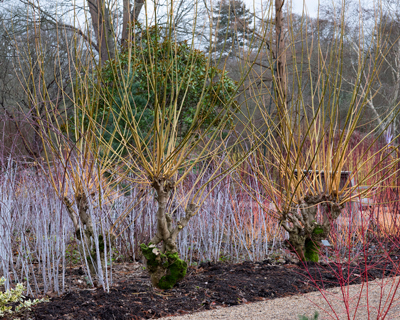10 award-winning (AGM) winter plants
Choosing plants that create impact and structure takes centre stage in winter, ensuring gardens continue to captivate even in the colder months
With flowers relatively sparse, structure is an important element in the winter garden. Many plants, trees and shrubs and even perennials, have a boldness of shape or intricacy of pattern to ensure that when there are few flowers to enjoy, our gardens can still interest and delight us. These RHS Award of Garden Merit (AGM) winning plants all provide attractive winter structural interest.
Acer negundo ‘Winter Lightning’ is a rarely seen form of the box elder. It naturally grows as a vigorous tree, but is best treated in the same way as dogwoods and willows with coloured stems. If you cut it back almost to the ground each spring, it will surge into production in winter with a bold mass of stout yellow stems that shine in the snow. It also features yellow autumn leaf colour. Height 2m when pruned (612ft). Hardiness rating H6.
Bergenia purpurascens var. delavayi is a familiar favourite combining colour, shape and a strong winter presence. Its bold form, vivid colouring, cold weather resilience and its adaptability all add to its appeal. From November until spring, when the pink flowers open, it’s invaluable. Try interplanting with snowdrops. Height 30cm (12in). Hardiness rating H5.
Betula utilis var. jacquemontii ‘Grayswood Ghost’ has distinctive upright white branches. It gleams across the garden even on the dullest of days. Quick growing, and showing its white
Twisted hazel Corylus avellana ‘Contorta’, when frost rimes its bare contorted branches, is a lovely winter shrub. It’s much less vigorous and more manageable than the untwisted form too. Its leaves are attractively contorted and if the occasional shoot is cut out for Christmas arrangements, those remaining show up more effectively against a bright blue sky. The red-leaved form, Corylus avellana ‘Red Majestic’, is also an AGM plant. Height 3m (10ft). Hardiness rating H6.
Mahonia × media ‘Lionel Fortescue’ is a bold evergreen that creates a forceful presence all year round, especially when they’re in their more upright phase, and before they mature into a rounded shape. The double rows of holly-like leaves, with their red midribs, are always imposing, and they support snow well – plus, of course, there’s the long strings of yellow flowers in November and December. Height 2m (612ft). Hardiness rating H4.
As the flower heads of Miscanthus sinensis ‘Septemberrot’ fade to tawny silver, the foliage passes through reddish tints, to biscuit brown, then drops away to leave the upright stems standing out against blue sky or an evergreen background. There are then months of winter interest to come before those tassels are finally blown away by spring gales. At that point, cut everything back hard to the ground. Height 2.4m (8ft). Hardiness rating H6.
Ophiopogon planiscapus ‘Kokuryu’ has genuinely black foliage. The gloss of the slender leaves and the rippling mass it creates as the plant steadily spreads at the front of the border creates emphatic winter impact. Interplanting with snowdrops or scillas, or a few artfully placed heads of Allium cristophii, completes the picture. Height 15cm (6in). Hardiness rating H5.
Phormium ‘Sundowner’ is an upright, substantial selection with big impact in winter. The bronzey-olive leaves are striped in pink and red towards the edges, especially when they first emerge and, although the tips can become ragged, this does not detract from the winter effect. Height 2.4m (8ft). Hardiness rating H3.
Well-behaved bamboo Phyllostachys nigra is effective through the winter in borders or in (large) pots. In their second year the upright canes mature to dusky black, sometimes shining jet black – a rare colouring and all the more visible after some of the leaves have fallen. The best colour comes on plants out of full sun that never dry out. Height 3m (10ft). Hardiness rating H5.
Salix × sepulcralis ‘Erythroflexuosa’ shows off attractively twisted stems and the leaves are twisted too. The distinctive form and colouring of this small tree or large shrub stands out against a blue winter sky or pale clouds. Graceful in growth, stems can be cut to add style to Christmas arrangements – and may well root in the water. Height 5m (16ft). Hardiness rating H5.


